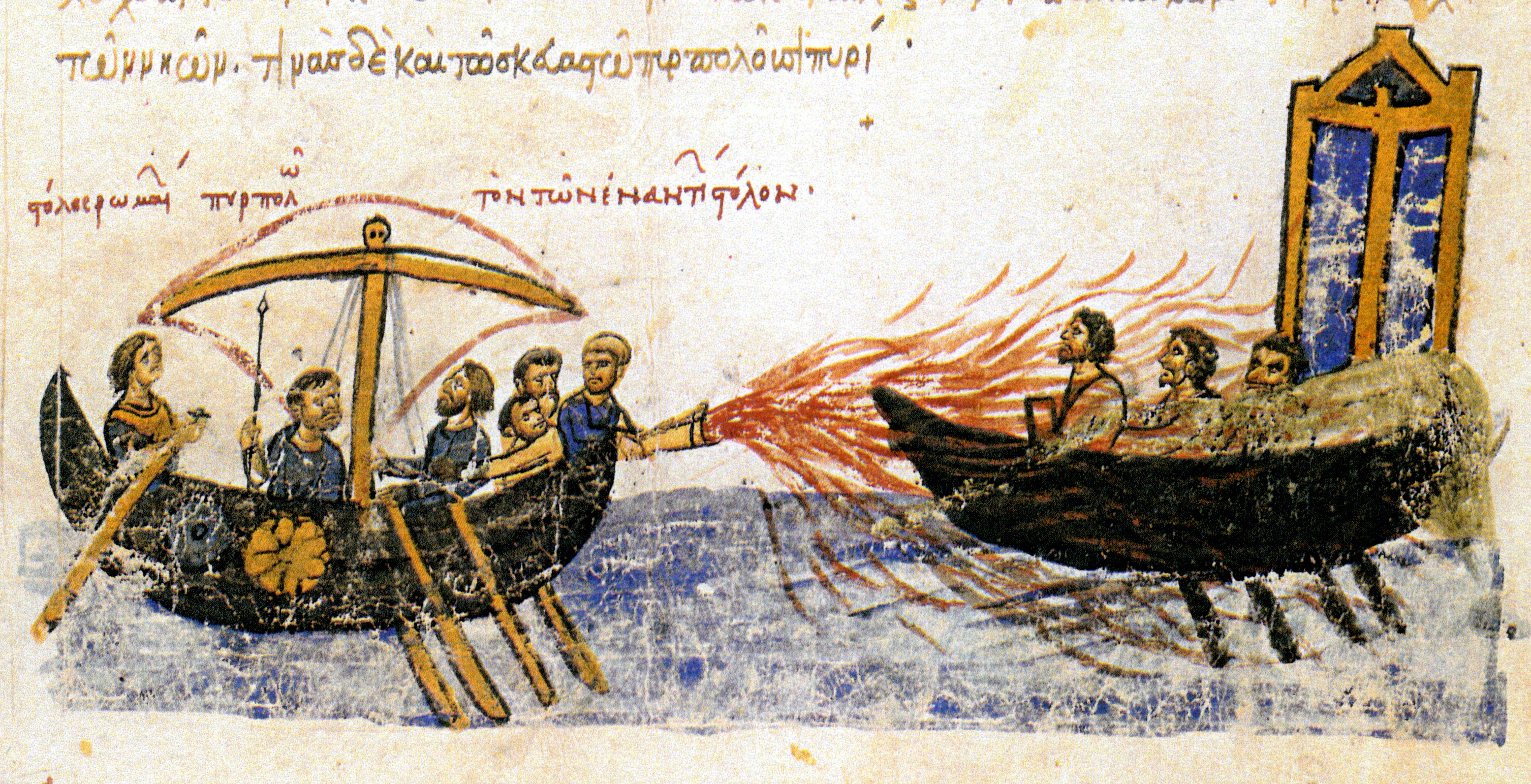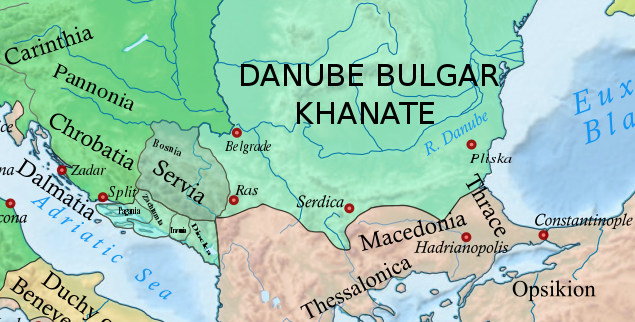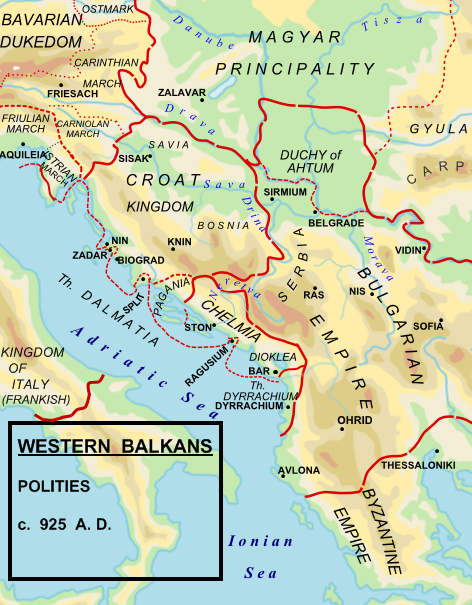|
Siege Of Ragusa (866–868)
The siege of Ragusa (modern Dubrovnik in Croatia) by the Aghlabids of Ifriqiya lasted for fifteen months, beginning in 866 until the lifting of the siege at the approach of a Byzantine fleet in 868. The failure of the siege and the re-appearance of the Byzantines in the region of Dalmatia signalled the beginning of new aggressive western policy by the new Byzantine emperor, Basil I. Its immediate effects were the re-establishment of Byzantine authority there in the form of the Theme of Dalmatia, and the beginning of the Christianization of the Slavs of the western Balkans, but within a few years it led to renewed Byzantine involvement and presence in southern Italy as well. Background At the beginning of the reign of Basil I the Macedonian in 867, Byzantine authority over Sicily and southern Italy had been much diminished due to the expansion of the Aghlabids of Ifriqiya; likewise, in the western Balkans, the local Slavic tribes—the Croats, Serbs, Zachlouboi, Terbounites ... [...More Info...] [...Related Items...] OR: [Wikipedia] [Google] [Baidu] |
Arab–Byzantine Wars
The Arab–Byzantine wars or Muslim–Byzantine wars were a series of wars from the 7th to 11th centuries between multiple Arab dynasties and the Byzantine Empire. The Muslim Arab Caliphates conquered large parts of the Christian Byzantine empire and unsuccessfully attacked the Byzantine capital of Constantinople. The frontier between the warring states remained almost static for three centuries of frequent warfare, before the Byzantines were able to recapture some of the lost territory. The conflicts began during the early Muslim conquests under the expansionist Rashidun Caliphate, part of the initial spread of Islam. In the 630s, Rashidun forces from Arabia attacked and quickly overran Byzantium's southern provinces. Muslim conquest of the Levant, Syria was captured in 639 and Arab conquest of Egypt, Egypt was conquered in 642. The Exarchate of Africa was Muslim conquest of the Maghreb, gradually captured between 647 and 670. From the 650s onwards, Arab navies entered the Medit ... [...More Info...] [...Related Items...] OR: [Wikipedia] [Google] [Baidu] |
Christianization Of The Slavs
The Slavs were Christianized in waves from the 7th to 12th century, though the process of replacing old Slavic religious practices began as early as the 6th century. Generally speaking, the monarchs of the South Slavs adopted Christianity in the 9th century, the East Slavs in the 10th, and the West Slavs between the 9th and 12th century. Saints Cyril and Methodius ( 860–885) are attributed as "Apostles to the Slavs", having introduced the Byzantine-Slavic rite ( Old Slavonic liturgy) and Glagolitic alphabet, the oldest known Slavic alphabet and basis for the Early Cyrillic alphabet. The simultaneous missionary efforts to convert the Slavs by what would later become known as the Catholic Church of Rome and the Eastern Orthodox Church of Constantinople led to a 'second point of contention between Rome and Constantinople', especially in Bulgaria (9th–10th century). This was one of many events that preceded the East–West Schism of 1054 and led to the eventual split between ... [...More Info...] [...Related Items...] OR: [Wikipedia] [Google] [Baidu] |
Rhentanoi
The Narentines were a South Slavic tribe noted as pirates on the Adriatic Sea in the 9th and 10th centuries. They occupied an area of southern Dalmatia centered at the river Neretva (). Named ''Narentani'' in Venetian sources, they were called ''Paganoi'', "pagans", by the Greeks, as they were still pagan after the Christianization of the neighbouring tribes. They were fierce enemies of the Republic of Venice, attacking Venetian merchants and clergy traveling through the Adriatic, and even raiding close to Venice itself and defeating the doge several times. Venetian–Narentine peace treaties did not last long, as the Narentines quickly returned to piracy. They were finally defeated in a Venetian crackdown at the turn of the 10th century and disappeared from sources by the 11th century. Terminology The word ''Narentine'' is a demonym derived from the local Neretva River (). The terms "Narentines", "Pagania" or "Pagans" are found in two contemporary sources: ''De Administrando I ... [...More Info...] [...Related Items...] OR: [Wikipedia] [Google] [Baidu] |
Duklja
Duklja ( sr-Cyrl, Дукља; ; ) was a medieval South Slavs, South Slavic state which roughly encompassed the territories of modern-day southeastern Montenegro, from the Bay of Kotor in the west to the Bojana river in the east, and to the sources of the Zeta (river), Zeta and Morača rivers in the north. First mentioned in 10th– and 11th-century Byzantine chronicles, it was a vassal of the First Bulgarian Empire, Bulgarian Empire between 997 and 1018, and then of the Byzantine Empire until it became independent in 1040 under Stefan Vojislav ( 1034–43) who rose up and managed to take over territories of the earlier Principality of Serbia (early medieval), Serbian Principality, founding the Vojislavljević dynasty. Between 1043 and 1080, under Mihailo Vojislavljević ( 1050–81), and his son, Constantine Bodin ( 1081–1101), Duklja saw its apogee. Mihailo was given the nominal title ''King of Slavs'' by the Pope after having left the Byzantine camp and supported an Uprising ... [...More Info...] [...Related Items...] OR: [Wikipedia] [Google] [Baidu] |
Kanalites
Kanalites (, sh-Latn-Cyrl, separator=" / ", Konavljani, Конављани) were a medieval Slavic tribe settled in the today's region of Konavle, within Dalmatia, Croatia, mentioned in the chapter titled "Of the Terbounians and Kanalites and of the country they now dwell in" of the 10th century ''De Administrando Imperio'' by Byzantine Emperor Constantine VII. The country, located in near proximity to Travunia, reportedly became desolated during the Pannonian Avars invasion, and its inhabitants are descendants from the unbaptized Serbs, from the time of the unnamed 7th-century Serbian ruler who came from Boiki and claimed the protection of the Emperor Heraclius in the 7th century. However, a closer reading suggests that the Constantine consideration about the population's ethnic identity, like in regard to other near polities, is based on Serbian political rule during the time of Časlav in 10th century and does not indicate ethnic origin. They were mentioned in the '' Vita Ba ... [...More Info...] [...Related Items...] OR: [Wikipedia] [Google] [Baidu] |
Travunija
Travunia ( sh-Latn-Cyrl, separator=" / ", Travunija, Травунија; ; ; ) was a South Slavic medieval principality that was part of Medieval Serbia (850–1371), and later the Medieval Bosnia (1373–1482). The principality became hereditary in a number of noble houses, often kin to the ruling dynasty. The region came under Ottoman rule in 1482. Its seat was in the city of Trebinje. In the 9th and 10th centuries, the '' Župa'' of Travunia was held by the Belojević noble family, who were entitled the rule during the reign of Prince Vlastimir (r. 830–850), of the Vlastimirović dynasty. After the death of Časlav, the last dynastic member, the principality disintegrated, and the provinces were annexed by the Bulgars and Byzantines. In 1034, Stefan Vojislav (the founder of the Vojislavljević dynasty) incited a rebellion and renounced Byzantine rule, becoming the ''Prince of Serbs'', ruling from the seat at Duklja. In the early 12th century, Desa of the Vukanović d ... [...More Info...] [...Related Items...] OR: [Wikipedia] [Google] [Baidu] |
Zachlumia
Zachlumia or Zachumlia ( sh-Latn-Cyrl, separator=" / ", Zahumlje, Захумље, ), also Hum, was a medieval principality located in the modern-day regions of Herzegovina and southern Dalmatia (today parts of Bosnia and Herzegovina and Croatia, respectively). In some periods it was a fully independent or semi-independent South Slavic principality. It maintained relations with various foreign and neighbouring powers (Byzantine Empire, First Bulgarian Empire, Kingdom of Croatia, Principality of Serbia) and later was subjected (temporarily or for a longer period) to Kingdom of Hungary, Kingdom of Serbia, Kingdom of Bosnia, and at the end to the Ottoman Empire. Etymology Zachlumia is a derivative of ''Hum'', from Proto-Slavic '' *xŭlmŭ'', borrowed from a Germanic language (cf. Proto-Germanic '' *hulma-''), meaning ''"Hill"''. South Slavic ''Zahumlje'' is named after the mountain of Hum (za + Hum "behind the Hum"), above Bona, at the mouth of the Buna. The principality is named ... [...More Info...] [...Related Items...] OR: [Wikipedia] [Google] [Baidu] |
Serbs
The Serbs ( sr-Cyr, Срби, Srbi, ) are a South Slavs, South Slavic ethnic group native to Southeastern Europe who share a common Serbian Cultural heritage, ancestry, Culture of Serbia, culture, History of Serbia, history, and Serbian language, language. They primarily live in Serbia, Kosovo, Bosnia and Herzegovina, Croatia, Montenegro as well as in North Macedonia, Slovenia, Germany and Austria. They also constitute a significant diaspora with several communities across Europe, the Americas and Oceania. The Serbs share many cultural traits with the rest of the peoples of Southeast Europe. They are predominantly Eastern Orthodoxy, Eastern Orthodox Christians by religion. The Serbian language, Serbian language (a standardized version of Serbo-Croatian) is official in Serbia, co-official in Kosovo and Bosnia and Herzegovina, and is spoken by the plurality in Montenegro. Ethnology The identity of Serbs is rooted in Eastern Orthodoxy and traditions. In the 19th century, the ... [...More Info...] [...Related Items...] OR: [Wikipedia] [Google] [Baidu] |
Croats
The Croats (; , ) are a South Slavs, South Slavic ethnic group native to Croatia, Bosnia and Herzegovina and other neighboring countries in Central Europe, Central and Southeastern Europe who share a common Croatian Cultural heritage, ancestry, Culture of Croatia, culture, History of Croatia, history and Croatian language, language. They also form a sizeable minority in several neighboring countries, namely Croats of Slovenia, Slovenia, Burgenland Croats, Austria, the Croats in the Czech Republic, Czech Republic, Croats in Germany, Germany, Croats of Hungary, Hungary, Croats of Italy, Italy, Croats of Montenegro, Montenegro, Croats of Romania, Romania, Croats of Serbia, Serbia and Croats in Slovakia, Slovakia. Due to political, social and economic reasons, many Croats migrated to North and South America as well as New Zealand and later Australia, establishing a Croatian diaspora, diaspora in the aftermath of World War II, with grassroots assistance from earlier communities an ... [...More Info...] [...Related Items...] OR: [Wikipedia] [Google] [Baidu] |
Slavs
The Slavs or Slavic people are groups of people who speak Slavic languages. Slavs are geographically distributed throughout the northern parts of Eurasia; they predominantly inhabit Central Europe, Eastern Europe, Southeastern Europe, and Northern Asia, though there is a large Slavic minority scattered across the Baltic states and Central Asia, and a substantial Slavic diaspora in the Americas, Western Europe, and Northern Europe. Early Slavs lived during the Migration Period and the Early Middle Ages (approximately from the 5th to the 10th century AD), and came to control large parts of Central, Eastern, and Southeast Europe between the sixth and seventh centuries. Beginning in the 7th century, they were gradually Christianized. By the 12th century, they formed the core population of a number of medieval Christian states: East Slavs in the Kievan Rus', South Slavs in the Bulgarian Empire, the Principality of Serbia, the Duchy of Croatia and the Banate of B ... [...More Info...] [...Related Items...] OR: [Wikipedia] [Google] [Baidu] |
Balkans
The Balkans ( , ), corresponding partially with the Balkan Peninsula, is a geographical area in southeastern Europe with various geographical and historical definitions. The region takes its name from the Balkan Mountains that stretch throughout the whole of Bulgaria. The Balkan Peninsula is bordered by the Adriatic Sea in the northwest, the Ionian Sea in the southwest, the Aegean Sea in the south, the Turkish straits in the east, and the Black Sea in the northeast. The northern border of the peninsula is variously defined. The highest point of the Balkans is Musala, , in the Rila mountain range, Bulgaria. The concept of the Balkan Peninsula was created by the German geographer August Zeune in 1808, who mistakenly considered the Balkan Mountains the dominant mountain system of southeastern Europe spanning from the Adriatic Sea to the Black Sea. In the 19th century the term ''Balkan Peninsula'' was a synonym for Rumelia, the parts of Europe that were provinces of the Ottoman E ... [...More Info...] [...Related Items...] OR: [Wikipedia] [Google] [Baidu] |
Sicily
Sicily (Italian language, Italian and ), officially the Sicilian Region (), is an island in the central Mediterranean Sea, south of the Italian Peninsula in continental Europe and is one of the 20 regions of Italy, regions of Italy. With 4.7 million inhabitants, including 1.2 million in and around the capital city of Palermo, it is both the largest and most populous island in the Mediterranean Sea. Sicily is named after the Sicels, who inhabited the eastern part of the island during the Iron Age. Sicily has a rich and unique culture in #Art and architecture, arts, Music of Sicily, music, #Literature, literature, Sicilian cuisine, cuisine, and Sicilian Baroque, architecture. Its most prominent landmark is Mount Etna, the tallest active volcano in Europe, and one of the most active in the world, currently high. The island has a typical Mediterranean climate. It is separated from Calabria by the Strait of Messina. It is one of the five Regions of Italy#Autonomous regions with s ... [...More Info...] [...Related Items...] OR: [Wikipedia] [Google] [Baidu] |








